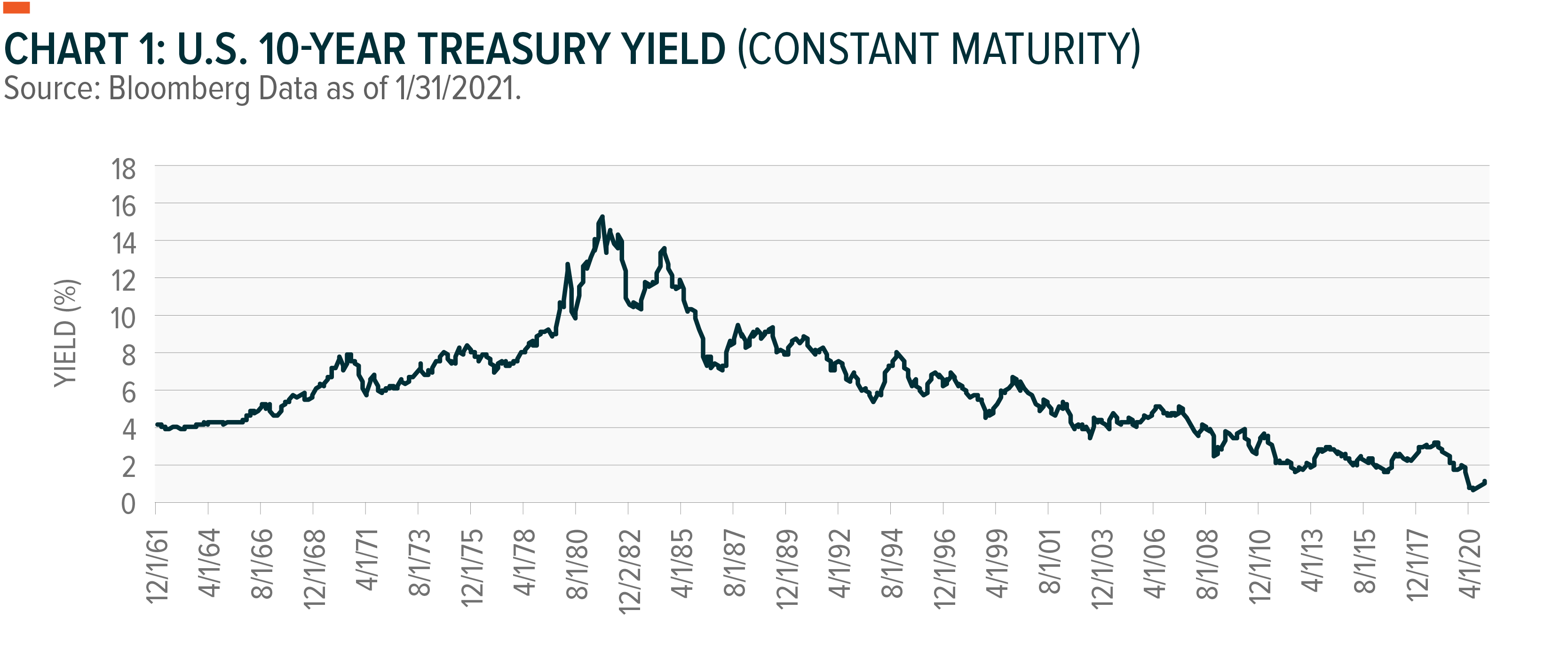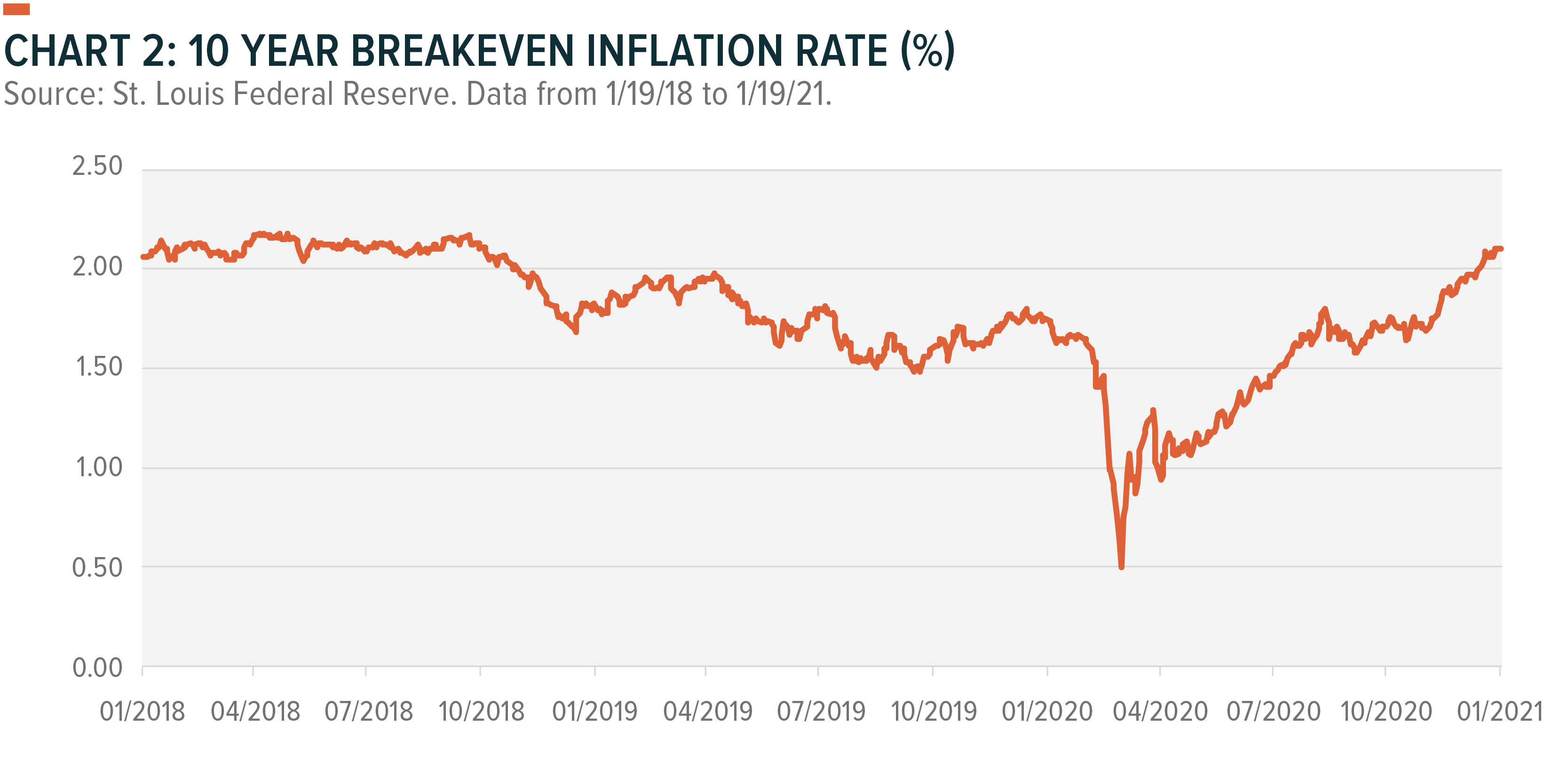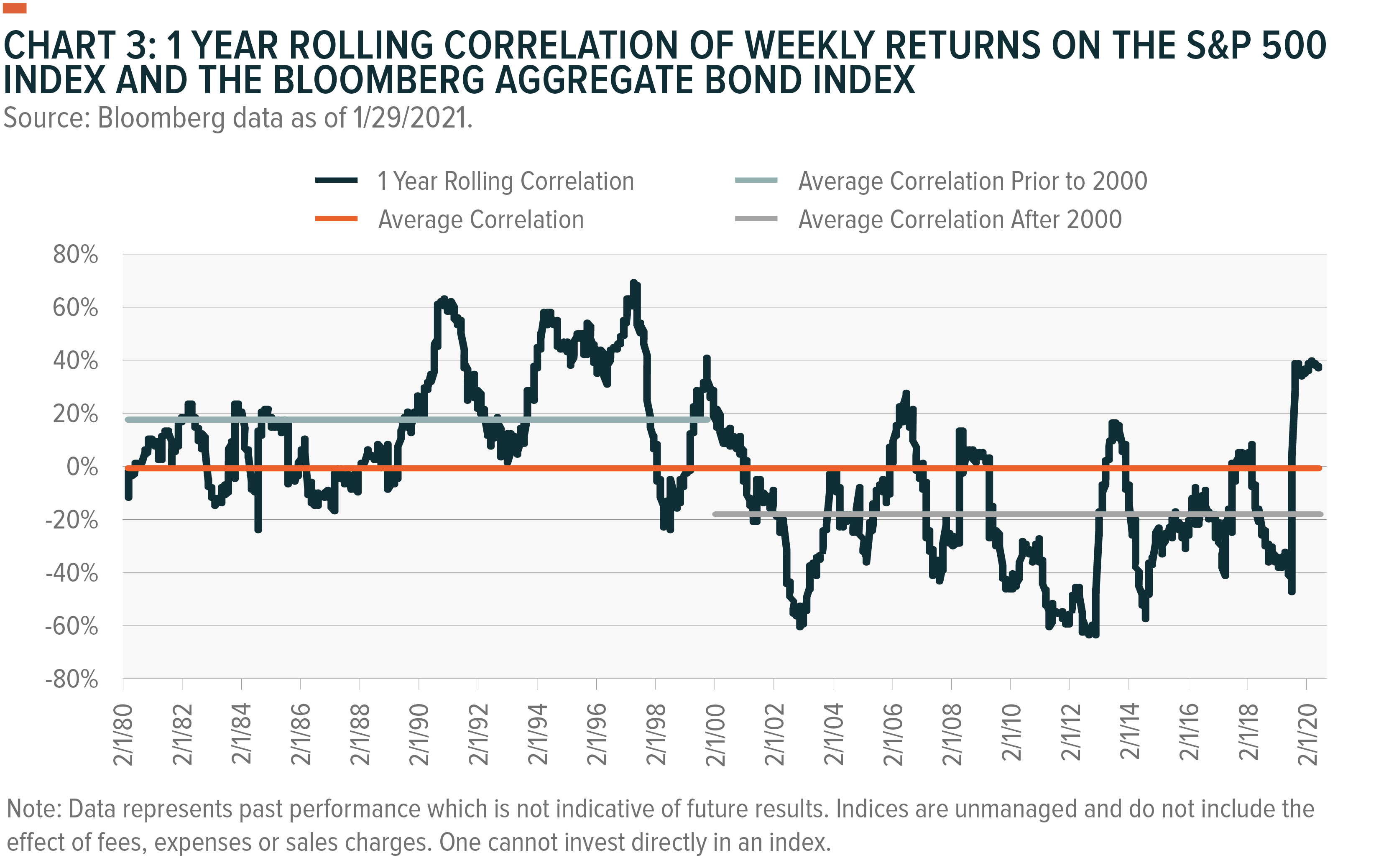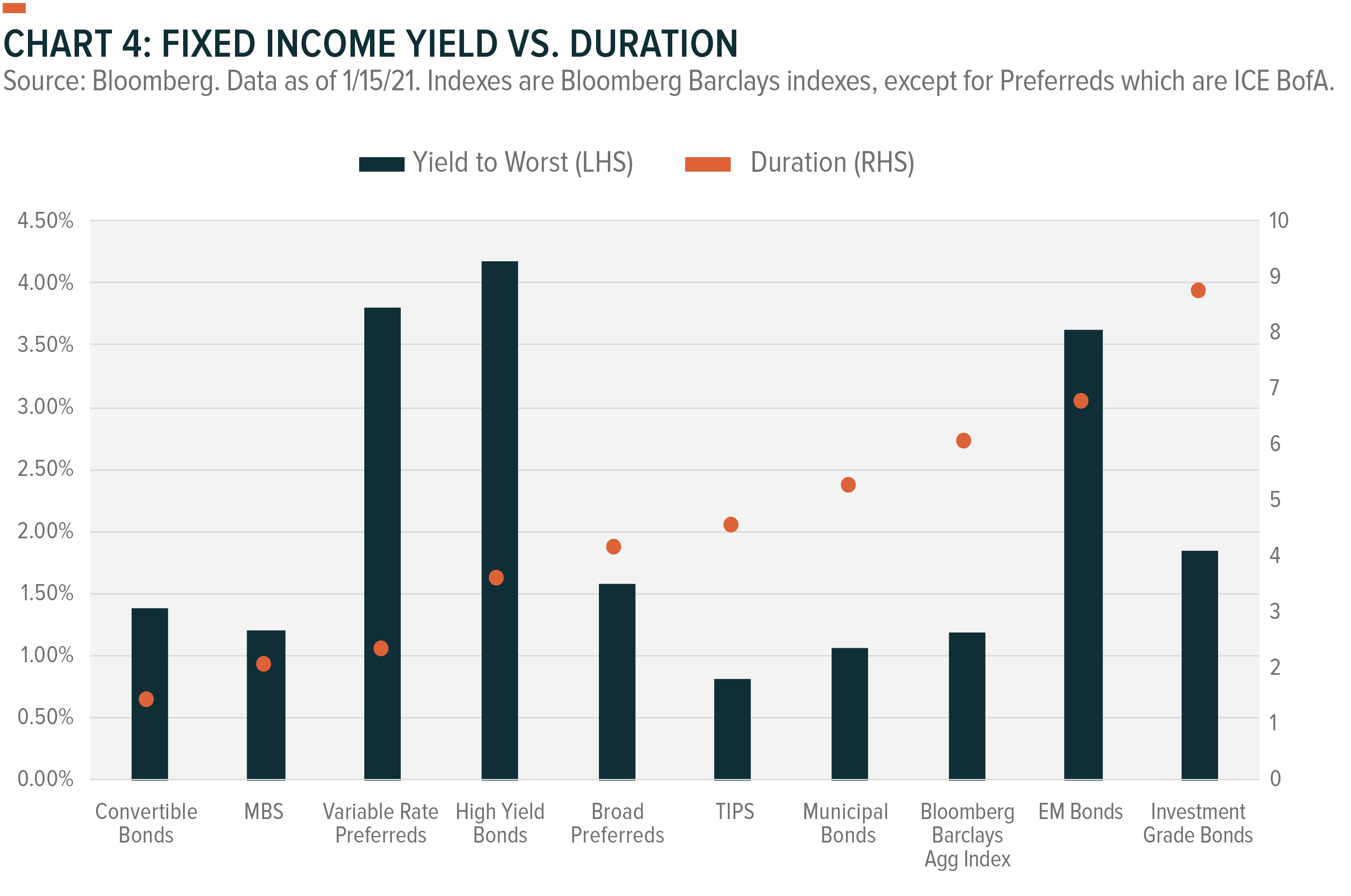Fixed income as either a security blanket or provider of higher income looks a little thin in early 2021. Following their downward trajectory over the last 30 years, U.S. policy interest rates are now at 0% while 10-year Treasury yields are hovering around 1%. Over the next few years, Treasury yields are more likely to rise than decline. Additionally, credit spreads are already near historic lows. These factors present a structural challenge for fixed income investors. However, with an aging population, there is an increased demand for income. This whitepaper explores different ways to find yield through equity income solutions and provides suggestions on how to balance risks when seeking such yield instruments.
Structural Headwinds Facing Traditional Fixed Income
In last year’s equity income whitepaper, we questioned how low can yields go. Owing to the pandemic and the resulting efforts by the Fed, we now have that answer. The goal of containing the virus meant portions of the economy had to be frozen, and that is where monetary and fiscal support was needed to plug the holes in the economy while the U.S. and the world attempted to contain the virus. The challenge of vaccinating the global population and hitting the reset button on the global economy is no small feat. Since March 2020, policy interest rates have been set at 0%; however, with fiscal policy becoming more supportive, inflation expectations have increased and has potentially moved forward the date when monetary policy is expected to become less supportive. Consequently, since early January 2021, the 10-year Treasury yield has been in excess of 1%.
During 2020, the decline in yields provided a boost for long-duration assets. But with longer term rates inching up, this trend began to reverse in August 2020. The 10-year Treasury yield started 2020 at 1.92% and was generally on a downward trajectory until early August when it reached an all-time low of 0.52%. It has since risen to its current reading of just over 1%.
Chart 1 illustrates the structural headwind facing fixed income. Since the 1980s the fixed income market has benefitted from declining yields. With yields near 0%, yields are more likely to rise over the next few years. This is likely to detract from fixed income returns, especially long-duration assets.

Inflation Expectations
In addition to rising yields being a headwind for fixed income, should higher inflation materialize, this will adversely impact the real returns on fixed income. Currently inflation expectations are rising with the Federal Reserve’s 5-year forward inflation expectations being just above 2% since the end of December. Since the 2020 presidential election, the current 10-Year Breakeven Inflation Rate reflects accelerating inflation expectations. While inflation expectations have risen, this is not yet reflected in common inflation measures like the Consumer Price Index (CPI). While realized inflation has increased from its lows in April and May, it remains well below its pre-pandemic levels.
With more than 10 million people unemployed, significant slack remains in the economy. However, as the economy reopens more fully in the second half, we expect a rebound in economic activity and employment. This has the potential to increase inflation. Additionally, higher crude prices may filter through the economy.
While we expect higher prices, we do not currently believe that inflation will be substantial or sustained. Fed Chair Jay Powell has indicated that the economy faces challenges particularly on the employment front before he expects sustained inflation, he also indicated that if inflation were to increase in unwelcome ways, the Fed would act.

Fixed Income’s Reduced Diversification Benefits
Traditionally, fixed income responds to economic factors differently than equities, and thus brings diversification potential to a portfolio. Since 2000, the average correlation between the S&P 500 Index and the Bloomberg Barclays U.S. Aggregate Bond Index is close to -18.9%. This correlation corresponds with a period where Federal Reserve (Fed) policy rates were reasonably stable and have been at low absolute levels.
But in 2020, equities and bonds increasingly moved in tandem. Market dislocations caused by COVID-19 uncertainties resulted in equity and bond markets declining together. And they then rebounded together following substantial monetary and fiscal stimulus during Q1 2020. Last year, the correlation between equities and fixed income increased to 40.3%.
With policy interest rates at 0%, fixed income’s diversification benefit will likely be muted until near the end of the current interest rate rising cycle. Treasury yields do not currently have room to decline significantly in response to market challenges. As such, widening credit spreads and the increased correlation between equities and corporate debt is likely to be the dominant factor during periods of economic turmoil. As such, there is the risk that low interest rates potentially increase the correlation between fixed income and equities during periods of market stress.

Demographic Shift Underway: Population Aging Has Implications
The aging population makes the income theme all the more important. By 2035, Americans over the age of 65 will exceed the number of children in the country for the first time ever. Complicating matters is that more than a third of private sector workers do not have access to a workplace retirement plan.1
In our 2019 PR Survey, 70% of affluent investors cited retirement planning as a primary investment goal, easily making it the most important financial goal for wealthier investors. But it was also the goal these investors were least confident in achieving. Just 65% of survey participants said they were confident in their ability to meet their retirement goals. Still, over 60% of them said that they expected to retire in less than five years.
The disconnect between the population demographics and confidence to live comfortably in retirement means income generation strategies will be critical. Conventional investments like fixed income are an option, but as we’ll see below, there are potentially better strategies for the older demographic.
Equity Income Presents Opportunities
Without meaningful yield available from traditional fixed income securities, a natural shift would be to explore equity income solutions. We believe that the macroeconomic environment favors investments with a high yield and low duration. A few areas that are potentially well positioned include variable rate preferreds, high dividend stocks and MLPs.2

Below we provide more detail on the different equity income areas.
Preferreds
Preferred equity has characteristics of both equity and fixed income. Within the capital structure, preferreds are above common equity and below bond holders. Holders of preferred equity receive dividend income ahead of common equity owners. While this protects the income component of preferreds, they don’t have the same price return potential as common equity. Preferreds have historically offered high yields compared to more traditional fixed income instruments. In addition, the yield from preferred stocks may be treated as qualified dividend income (QDI) rather than as ordinary income, resulting in favorable taxation.
Within the current environment, variable rate preferreds provide a solid yield relative to their duration. Referring to the chart above, high yield bonds also provide an attractive yield relative to their duration. However, at this stage we favor preferreds over high yield bonds due to the extremely tight credit spreads on high yield bonds. High yield spreads ended 2020 at the same level they started 2020, 3.27%, and have continued to decline during the first month of 2021.3 This comes despite substantially greater risks in the economy. With the economy still recovering, we are cautious on credit risk. Variable rate preferreds have a higher overall credit quality than high yield bonds. At a BBB- rating at the index level, this is four notches higher than the B+ rating for high yield bonds.4
For more information on preferreds, please refer to our Preferred Report.
High-Yielding Equities and MLPs
Greater fiscal stimulus has the potential to increase inflation expectations while supporting a faster economic recovery. This is most beneficial for value, cyclical and small-cap companies. These three areas have the most to gain from fully reopening the economy. The U.S. is on track to provide significant fiscal stimulus. This has the potential to support smaller companies that have higher domestic exposure. High dividend stocks, which often have factor exposures to Size and Value, could be primed for a rebound during an inflationary period.
Energy, Materials, Financials and Industrials are sectors that we believe are well positioned to benefit from the reflation trade. Energy has the most to gain from community mobility being restored to pre-pandemic levels. Since the first COVID vaccine released encouraging phase 3 trail results, WTI crude prices have increased from around $40 / barrel to the mid- $50s.5 Rising oil prices have been beneficial to the Energy sector and Master limited partnerships (MLPs), which also stand to potentially gain from increasing energy production as a result of the higher prices.
Historically, Master Limited Partnerships (MLPs) are one of the highest-yielding equity income products available. They are also one of the few products that provides a higher current yield than five years ago. MLPs are a unique hybrid legal structure that combines the tax benefits of a private partnership with the liquidity of a publicly traded company. Similar to a Real Estate Investment Trust (REIT), MLPs pay mandatory regular dividends.
For more information on high-yielding assets, please see our Income Monitor as well as our most recent insights on MLPs.
Quality Dividends
Quality dividends are sometimes nicknamed the blue-chip dividend strategy because these companies are seen as being higher quality and more financially stable than other dividend-paying stocks. Blue chips are often name brand stocks investors are familiar with and hold onto for longer periods than other stocks. The defensive characteristics of these stocks make them more likely to maintain their dividends across varied economic environments, compared to other types of dividend stocks.
The tradeoff is the yield tends to be lower than their high dividend counterparts. However, their attractive financial profile often makes them a core strategic holding for long-term investors with income needs. The quality dividend space tends to lean more toward sectors like Consumer Staples, which have a longer track record of paying dividends.
For more information, please see our primer on dividend strategies.
Covered Calls
While covered calls do not stand to benefit from the reflation trade, they are a good way to diversify the sources of yield within an equity income portfolio. Covered calls are a great way to generate income in a rangebound market. A covered call sells away upside potential and receives a premium in return. The premium becomes the income that the product generates. When volatility rises, the premium received rises to compensate for the higher level of volatility. Through the income provided by covered calls relating to the level of volatility in the market, it is unlikely that this income will decline simultaneously to a significant number of high yielding companies having to cut or suspend their dividend payments.
In a market trading within a reasonably tight range, covered calls benefit from receiving the premium income and potentially a small improvement in the underlying equities (or other) while not having the underlying called.
In a rising market, covered calls underperform the overall market due to the underlying being called. This affects the total return, not the income produced by the product.
In a declining market, covered calls provide a small buffer of protection because they receive the premium income.
For more information on covered calls, refer to our more in-depth explanation of covered calls.
Holistic Approach to the Search for Higher Yields
Attaining a high yield is important. However, we believe the approach is important too. In our view, it is essential to take a holistic approach that considers the sustainability of that yield and the investment from a total return perspective.
Equity income solutions can fall into similar sectors and segments of the market, and thus may be affected by similar economic and market factors. When developing an equity income portfolio, diversification across equity income strategies is critical. It’s just as critical to round out the exposure with positions that can provide total return in environments where value and dividend exposure is out of favor. In line with this, we advocate incorporating sector and industry exposures that are systematically lacking within traditional equity income portfolios.
Conclusion
Near cycle low interest rates and the risk of reflation presents an uphill battle for traditional fixed income. We believe the current macroeconomic environment is favorable for yield seeking investors to use equity income solutions. While fixed income is likely to be adversely impacted as the economy recovers and the long-end of the yield curve rises, equities stand to benefit from the improving economy, the prospect of further fiscal stimulus and potentially an infrastructure plan.
Equity income solutions have the potential to provide a high level of yield without the duration risk. Additionally, a reflationary environment is favorable for high dividend equities. Value, cyclical and small-cap equities have the most to gain as the economy more fully reopens.
In our view, the reflationary focused portions of the equity income space are reasonably well positioned in the near term. But this is just a portion of the equity income universe and diversification in both exposures and yield is always an important consideration when creating a yield focused portfolio to see one through both good and the bad times.
 Michelle Cluver
Michelle Cluver